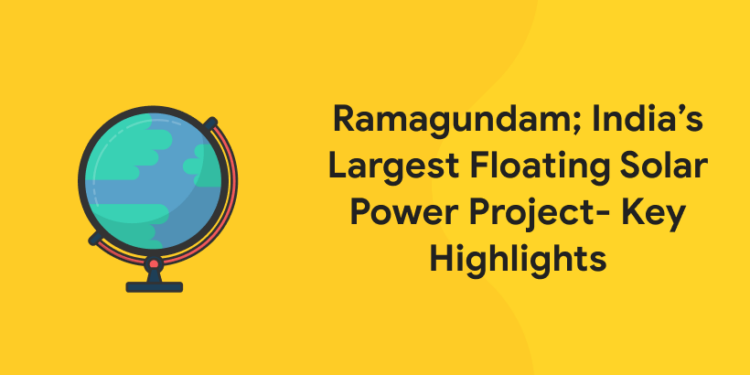Table of Contents
The most evident environmental benefit is the reduced land demand, which is largely for associated evacuation plans. Additionally, the presence of floating solar panels helps conserve water by reducing evaporation from aquatic bodies.
Floating solar plant in india power facility is now fully operational. The 100 MW Ramagundam Floating Solar PV Project is located in Ramagundam, Telangana. The project’s final 20 MW of capacity received commercial operational certification from NTPC on July 1.
What are Floating Solar Panels?
The phrase “floating solar” or “floating photovoltaics” (FPV), also referred to as “floatovoltaics,” describes solar panels that are mounted on a platform that floats on a body of water, typically a lake, reservoir, or, under the right conditions, the sea.
These buildings are typically anchored on calmer areas of water, such as ponds, lakes, or reservoirs. These systems are quite simple to construct, don’t need clearing vegetation or leveling the ground, and run quietly.
Since 2016, the market for this renewable energy technology has reportedly grown significantly, according to reports. The first 20 plants, each with a capacity of several dozen kWp, were built between 2007 and 2013. Electricity installed reached 3 GW in 2020, and 10 GW is predicted by 2025. Cost-wise, a floating system is 20–25 percent more expensive than a ground-mounted system.
Ramagundam Project
1: Who was the first woman President of India?
The Ramagundam Project’s cutting-edge technology and environmentally friendly features are its main selling points. The NTPC’s Regional Executive Director for the South, Naresh Anand, praised the staff at NTPC-Ramagundam for reaching the milestone and underlined NTPC’s commitment to environmentally friendly energy.
With the full capacity operation of the 100 MW solar PV facility at Ramagundam, the total commercially operational floating solar capacity in the Southern Region has climbed to 217 MW. Anand said that the NTPC Southern Region had already declared the 25 MW and 92 MW floating solar projects in Simhadri, Andhra Pradesh, and Kayamkulam, Kerala, respectively, to be commercially operational.
Each segment has a 2.5 MW capacity and is divided into 40 blocks. Each block of the floating structure has 11,200 solar panels. The floating structure consists of one inverter, a transformer, and a high-tension breaker. On floaters built of HDPE (High-Density Polyethylene) material, photovoltaic systems are attached.
The dead weights placed at the bottom of the balancing reservoir are attached to the overall floating arrangement using a special HMPE (High Modulus Polyethylene) rope. Up till the present switchyard, the power is evacuated using 33 KV underground lines.
Attempt Free General Knowledge Mock test! Download Entri App!
Free UPSKILLING Courses!
Take your first step toward mastering in-demand skills, acing interviews, and securing top-tier jobs with Entri's free upskilling courses.
Start Learning!Environment Benefits of the Project
The most obvious advantage from an environmental perspective is the minimal amount of acreage necessary, mostly for associated evacuation preparations.
Furthermore, the presence of floating solar panels slows the pace at which water evaporates from bodies of water, contributing to water conservation. The floating solar panels at the power station will prevent 32.5 lakh cubic meters of water from evaporating from the reservoir each year.
The water body beneath the solar arrays would also help to maintain the temperature, boosting production and efficiency. Additionally, it will cut yearly coal usage by 1.65 lakh tonnes and carbon dioxide emissions by 2.1 lakh tonnes.
What are the Related Challenges?
Expensive to Install
- Installing floating solar panels costs more than installing a conventional PV system.
- The fact that the technology is relatively new and needs specialized training and tools is one of the key causes.
However, it is anticipated that installation prices will decrease as technology improves.
Limited Application
- Large-scale floating solar arrays are common, and they offer electricity to sprawling cities, businesses, or utilities.
- Therefore, it is more practical to choose rooftop installation or ground-mounted solar.
Understanding of Water-bed Topography
- Understanding the geography of the waterbed and whether it is suitable for setting up anchors for floats is essential when developing floating solar systems.
Attempt Free General Knowledge Mock test! Download Entri App!
Key things to know about the floating solar project
- The floating solar plant in india project covers 500 acres of the water reservoir, preserving important land resources and preventing evaporation to conserve water.
- High-density polyethylene (HDPE)-made floaters are used to support the solar panels.
- A total of 40 blocks, each with 2.5 MW, make up the facility. An array of 11,200 solar panels and one floating platform are also included in each block.
- A single inverter, transformer, and high tension (HT) breaker make up the floating platform.
- Aside from having cutting-edge technology, the Ramagundam solar project also has eco-friendly features.
- It was built using an Engineering, Procurement, and Construction (EPC) contract from M/s BHEL at a cost of Rs 423 crore.
- Through an unique High Modulus Polyethylene (HMPE) rope, the complete floating system is fastened to the dead weights positioned in the balancing reservoir bed.
- In order to evacuate the power up to the current switch yard, 33KV underground cables are used.
- The overall commercial operation of floating solar capacity in the Southern Region has increased to 217 megawatts with the operationalization of the 100-MW Solar PV Project (MW).
- With effect from July 1, 2022, NTPC declared the remaining 20 MW of the 100 MW Ramagundam Floating Solar PV Project in Telangana to be in commercial operation.
- Earlier, NTPC announced the commercial operation of two floating solar projects: 25 MW at Simhadri and 92 MW at Kayamkulam (Kerala) (Andhra Pradesh),
- Under the government of India’s “Make in India” initiative, all significant parts of the solar plant, including as the floaters, switchgear, and biodegradable natural ester oil-filled inverter-duty transformers, were developed domestically.
I hope you found this article useful. The secret to clearing an exam is to prepare methodically and strategically. If you’re a candidate looking to start your dream job but don’t know where to start, our Entri app has you covered. Our staff will provide you with content and insights on the topics that affect you. Become a member of our app today and enroll in one of the many programs available. Stay up to date on various elements of the subject you’re interested in by using the app. Please feel free to leave any questions or concerns in the comments area. We will make every effort to reach back. Remove any self-doubts and negative thoughts from your mind. Make an effort to maintain a clear viewpoint. Consider why you desire this. Concentrate on the positive aspects of your situation and work diligently. Each day is a valuable gift that has been placed upon us, so make the most of it. Make an effort to improve yourself. Today is the day; let’s hope it goes well. Best wishes.













